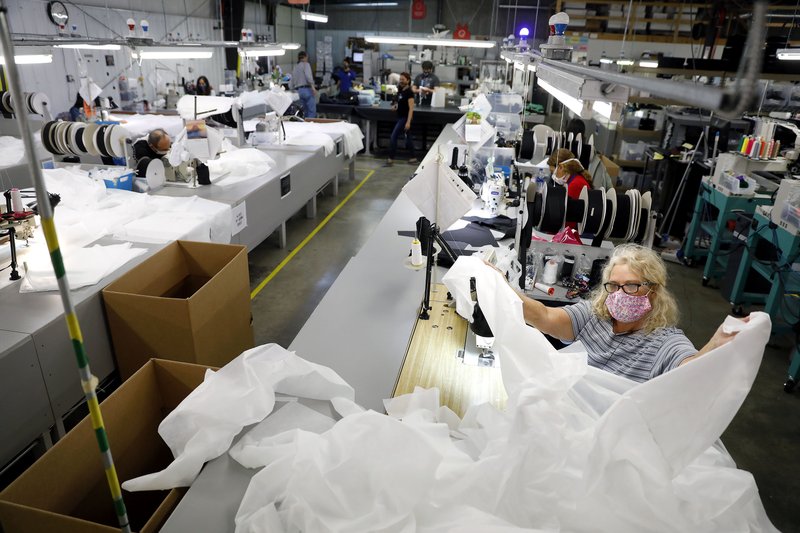WASHINGTON -- Wholesale prices slid a record 1.3% in April led by a 19% plunge in the cost of energy, further signaling the potential threat of deflation in the United States.
The Labor Department said that its producer price index, which measures inflation before it reaches the consumer, fell by the largest level on records dating to 2009 as the disruptions from the coronavirus pandemic rattled the U.S. and the global economy.
So-called core prices, which exclude food and energy, increased 0.6% in the year ended in April, the smallest annual gain since the end of 2015. Core costs fell 0.3% from a month earlier.
The report Wednesday comes one day after the U.S. said consumer prices declined 0.8% in April, the steepest month-to-month fall since the 2008 financial crisis.
[CORONAVIRUS: Click here for our complete coverage » arkansasonline.com/coronavirus]
The decline of prices at both the retail and wholesale levels could be an early warning signal that the seismic evaporation of demand brought on by a pandemic could ignite a destabilizing bout of deflation, something not seen in the United States since the economic collapse of the 1930s.
"The economy is on deflation watch for producers and consumers now that economic demand is falling away more quickly than anytime ... since the Great Depression," said Chris Rupkey, chief financial economist at MUFG Bank in New York. "Inflation isn't coming back in this economy for a long, long time."
Gregory Daco, chief economist at Oxford Economics, said the report on wholesale prices was "stark evidence" that the virus-related recession was having a strong deflationary effect on the economy.
Federal Reserve Chairman Jerome Powell, delivering a webcast sponsored by the Peterson Institute, said Wednesday that there was a threat of a prolonged recession and Congress and the administration needed to do more to cushion the economy. He continued to pledge further support from the Fed, which has cut its benchmark interest rate to a record low near zero.
"Deeper and longer recessions can leave behind lasting damage in the productive capacity of the economy," Powell said.
While the decline in energy prices has accelerated, it was the third-consecutive month of falling prices, illustrating how the global economy was already slowing before the arrival of the coronavirus. The outbreak only exacerbated the trend.
Food prices at the wholesale level also fell in April, dropping 0.5%, although that decline could be reversed in coming months given shortages that have started to appear in such areas as meat and pork products.
The cost of goods fell 3.3% from a month earlier, the biggest decrease in data back to 2009. Two-thirds of the slide in goods prices reflected an almost 57% slump in gasoline, the largest decline in records to February 1947.
Producer prices excluding food, energy, and trade services -- a measure preferred by economists because it strips out the most volatile components -- fell 0.9% from the previous month and 0.3% from a year earlier.
Over the past 12 months, wholesale prices are down 1.2%, a further indication that inflation pressures are remaining dormant.
While wholesale and consumer prices have dropped overall, retail food prices surged 2.6% from the previous month, the most since 1974, as Americans stocked up at grocery stores. U.S. consumers paid 4.3% more in April for meats, poultry, fish and eggs, 1.5% more for fruits and vegetables, and 2.9% more for cereals and bakery products, the Labor Department said.
Overall, consumers paid 2.6% more in April for groceries, the largest one-month jump since February 1974.
The jump in food prices came in a month when more than 20 million Americans lost their jobs,.
The increase in cereal and bakery products was the steepest single-month increase on record, which goes back to 1919, according to Geri Henchy, director of nutrition policy for the Food Research & Action Center, a nonprofit organization working to eradicate poverty-related hunger.
She attributes the inflated prices to two things: a shift in where consumers are purchasing their food, and supply chain disruptions from virus outbreaks in food production facilities as well as slowdowns related to social distancing and sheltering in place.
Information for this article was contributed by Martin Crutsinger of The Associated Press; by Vince Golle of Bloomberg News; and by Laura Reiley of The Washington Post.
Business on 05/14/2020
